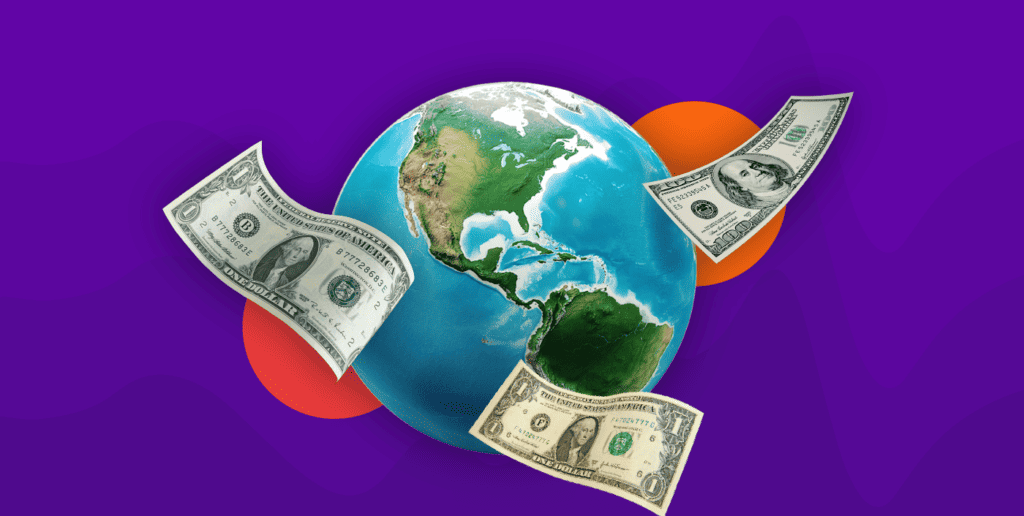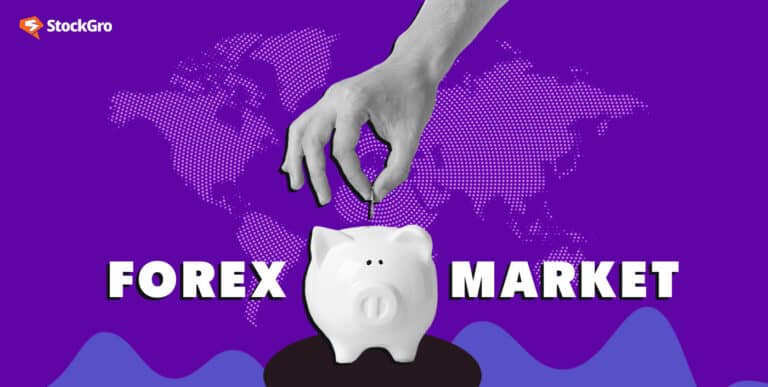
Did you know Kuwaiti Dinar is the strongest currency in the world? That’s right. 1 Kuwaiti Dinar is equal to USD 3.26. Now, here’s another fact – eight more currencies are stronger than the US Dollar, making it the tenth strongest currency, as per Forbes Advisor. And yet, the US dollar is considered the ‘currency of the world’. Why? Time to find out!
Which are the strongest currencies in the world?
Before getting into the crux of the topic, here’s a bit of clarification. Nine currencies rank higher than the US Dollar purely because of positive currency exchange. In other words, in exchange for those currencies, you get more than a dollar.
And yet, you wouldn’t ever see global oil prices being announced in Kuwaiti Dinar or Jordanian Dinar (JOD). Moreover, most of these currencies are “pegged” to the US dollar. So, their value relative to another currency (US dollar for example) will remain constant.
| Rank | Name of Currency | Floating/Pegged | Value in US dollar |
| 1 | Kuwaiti dinar (KWD) | Pegged | $3.26 |
| 2 | Bahraini dinar (BHD) | Pegged | $2.65 |
| 3 | Omani rial (OMR) | Pegged | $2.60 |
| 4 | Jordanian dinar (JOD) | Pegged | $1.41 |
| 5 | British pound sterling (GBP) | Floating | $1.20 |
| 6 | Cayman Islands dollar (KYD) | Pegged | $1.20 |
| 7 | Gibraltar pound (GIP) | Pegged | $1.20 |
| 8 | Swiss Franc (CHF) | Floating | $1.07 |
| 9 | Euro (EUR) | Floating | $1.07 |
| 10 | US dollar | Floating | $1 |
Contrary to this, our beloved INR or the British Pound Sterling is entirely “floating”, So their value relative to other currencies keeps fluctuating based on global demand and supply.
Before diving into the powerful US dollar, here’s one more interesting tit-bit – apart from the currencies mentioned in the table, all other currency units are worth less than a dollar. So, Re. 1 is equal to USD 0.012.
You may also like: All you need to know about India’s first Retail REIT – Nexus Select IPO
Why is the dollar the main currency in the world?
Well, because most international transactions happen in the US dollar. But then again, why? There are many factors which contributed to the US dollar’s global domination. And it all started more than a century ago, in 1914, during World War I.
What is the origin of the dollar?
The US dollar that you know today was first printed in 1914, after the establishment of the Federal Reserve Bank, the country’s financial watchdog. Incidentally, this was the time when the US economy achieved its No. 1 spot. However, most transactions continued in the British pound.
Then, WWI happened. And the Allies began purchasing supplies from the US. The latter had not joined the global conflict. At this point, several countries gave up the Gold Standard system i.e., wherein currency value was decided in terms of gold, or currency pegged to gold.
Imagine exchanging a precious metal like gold for nominal supplies. A costly affair indeed. And so, these countries decided to instead transact in paper money. And decided to peg their currency to the US dollar. The UK eventually too, decided to suspend the Gold Standard system for some time.
Then, WWII happened. At that point, most countries were still paying the US in gold for weapons and other supplies. Invariably, the US became the largest owner of global gold, and it was next to impossible for countries to return to the Gold Standard system.
Read also: All you need to know about the basics of forex trading in India
Presenting the Bretton Woods agreement
Realising this in 1944, as many as 44 allied nations united in Bretton Wood, New Hampshire, USA, to discuss the global currency arrangement moving forward – rather than pegging to gold, currencies would now be pegged to the US dollar.
Interestingly to note, the US dollar was itself pegged to gold. But they had all the gold supply in their hands and hence, would not have faced any issue returning to the Gold Standard.
And thanks to the Bretton Woods agreement, the US Dollar was officially crowned as the world’s reserve currency!
Reasons for US dollar domination
Reason 1: Economic strength of the US
Along with printing their first-ever official currency, the US was already the world’s largest economy. A century later, it still enjoys the No. 1 spot with a gross domestic product (GDP) of USD 25.46 trillion.
Fun fact: the US economy was the first to reach the ‘trillion-dollar’ economy status, as early as 1970. Here’s a look at how the US economy fared in the past 6 decades:
What is the size of the US economy? (2022-1965)
| Year | GDP of US (in USD billions) |
| 2022 | $25,460.000 approx. |
| 2020 | $20,936.600 |
| 2015 | $18,036.650 |
| 2010 | $14,964.400 |
| 2005 | $13,093.700 |
| 2000 | $10,284.750 |
| 1995 | $7,664.050 |
| 1990 | $5,979.592 |
| 1985 | $4,346.717 |
| 1980 | $2,862.492 |
| 1975 | $1,688.900 |
| 1970 | $1,075.900 |
| 1965 | $712.082 |
The No. 1 spot is enough to attach stability and resilience to the US dollar for influencing global trade and finance. And this stability stands as a sign of encouragement for countries to use the dollar as the global medium of exchange.
Note: While the country enjoys the No.1 spot, US debt has mounted to a gigantic USD 30.93 trillion in 2022 from a mere USD 408 billion in 1922. In fact, the country is inching closer to defaulting on loan repayment unless the US Federal Reserve finds a solution soon enough.
The possibility of defaulting, however, becomes the biggest threat to the US dollar’s status as a ‘global currency’.
Reason 2: Currency of foreign exchange reserves
The Bretton Woods’s agreement of crowning the US dollar as the world’s reserve currency is going strong today. At least this is what the International Monetary Fund (IMF) data on foreign exchange reserves suggests –
Most foreign exchange reserves are stored in mainstream currencies like the US dollar, Euro, Chinese renminbi, Japanese yen, British pound sterling, and Australian dollar, among others.
But the maximum amount of forex reserves are stored in the US dollar:
| Total foreign exchange reserves (in USD billion) | Forex reserves stored in US dollar (In USD billion) | % of forex reserves in USD | |
| Q4 2021 | $12,919.38 billion | $7,085.01 billion | 54.84% |
| Q1 2022 | $12,542.51 billion | $6,875.00 billion | 54.81% |
| Q2 2022 | $12,032.64 billion | $6,652.96 billion | 55.29% |
| Q3 2022 | $11,618.73 billion | $6,441.18 billion | 55.43% |
| Q4 2022 | $11,962.89 billion | $6,471.28 billion | 54% |
Looking at the percentage, it’s clear that more than half of global foreign exchange reserves are stored in the US dollar, compared to other global currencies. This, again, is a contributing factor to the US dollar’s global domination.
Reason 3: NYSE being the largest stock exchange
According to Statista, The New York Stock Exchange (NYSE) is the largest and richest stock exchange in the world, valued at USD 25.15 trillion, as of April 2023.
Closely following suit is Nasdaq, another stock exchange based in the US, with a market capitalization of USD 18.99 trillion, during the same period. Remember that no other stock exchange has managed to cross the USD 10 trillion figure.
With contributions from other minor stock exchanges, the total market capitalisation of the US stock market amounts to USD 40 trillion.
These impressive figures are bound to attract global investors and ensure a consistent flow of capital within the economy. This capital flow invariably, means active circulation of the US dollar, thus, reinforcing the currency’s domination.
Also read: How to Invest in US Stocks from India?
Additionally, other reasons include the domination of the petrodollar system (exchanging oil for US dollars; not any other currency), several currencies still being pegged to the US dollar, etc.
The world however, wonders whether the 21st century will witness a decline in the US dollar’s domination. Especially when China is vying to make its yuan the global currency, giving stiff competition to greenback.
Not to mention, BRICS countries (Brazil, Russia, India, China and South Africa) are looking to introduce an alternate common currency for international trade. Again, a jolt to the US dollar’s ‘global currency’ status.
And yet, many feel that replacing the almighty dollar is a decade’s worth of work if not 50 years. At least, it won’t happen anytime soon.



1 Comment